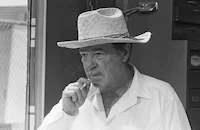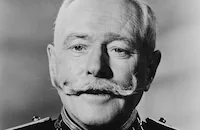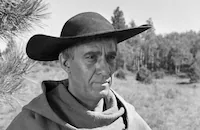Fortunes of Captain Blood

Brief Synopsis
Cast & Crew
Gordon Douglas
Louis Hayward
Patricia Medina
George Macready
Alfonso Bedoya
Dona Drake
Film Details
Technical Specs

Synopsis
In the seventeenth century, Irishman Peter Blood, captain of the Avenger , is one of the most daring buccaneers in the West Indies. Before he became a pirate, Blood was a doctor in Ireland, and was arrested during the Monmouth Rebellion for treating a wounded rebel. He later escaped from slavery in the West Indies, and now plunders Spanish ships. Charles II, King of Spain, charges the Marquis de Riconete, governor of a West Indian island, with the capture of the English pirate. Blood seems to be playing into his hands when some of his men, who have gone ashore for supplies, are betrayed by their supplier and captured by slave trader George Fairfax. The marquis tortures the men, but is unable to extract Blood's whereabouts from them. When Blood learns that the marquis' ship is temporarily disabled, he decides the time is right to rescue his men from the island. Disguised as a fruit seller, Blood first seeks out the man who betrayed them, only to discover that he has been hanged. Then Blood learns from flirtatious Pepita Rosados that many of the slaves, who dive for pearls in shark-infested waters, have died, and is even more determined to rescue the surviving ones. Isabelita Sotomayor, the marquis' niece, is in love with Fairfax, despite the disapproval of her uncle. Bored with life on the island, she offers Fairfax money to take her to Spain. Meanwhile, Blood befriends the slaves' overseer, who leads him to Fairfax. Blood and Fairfax dicker over the slaves until Isabelita interrupts with the announcement that the marquis' ship has been repaired, and that she will be sent away on it. Shortly, the marquis' men, who have followed Isabelita, attempt to arrest Fairfax. Fairfax is wounded in the ensuing fight, and Blood takes him to Billy Bragg's tavern and treats his injury. After Fairfax inadvertently reveals that he is more interested in Isabelita's money than he is in her, Blood, who is still disguised as the fruit seller, offers to take her to Spain if she asks her uncle to pardon him for attacking the soldiers. Isabelita arranges this, and Blood takes the opportunity to discover which seal the marquis uses when he orders men released from prison. That night, he sneaks into the marquis' office and forges releases for his men, but uses the wrong seal. After Blood presents the release, a guard notices that the seal is incorrect, and a battle ensues, but Blood and his men manage to escape with only a few casualties. Later, in order to stop the marquis from torturing Bragg, Isabelita, believing that Blood and his men have already set sail, reveals his whereabouts. When she subsequently learns that the tide has prevented him from leaving, she and Bragg hurry off to warn him. Before Blood can escape, however, the marquis' ship appears on the horizon, and a bloody battle follows. After Blood and his men declare victory, Isabelita announces that she will stay on the island in order to help institute a new, freer government.

Director

Gordon Douglas
Cast

Louis Hayward
Patricia Medina

George Macready

Alfonso Bedoya

Dona Drake

Lowell Gilmore
Wilton Graff

Curt Bois
Lumsden Hare

William Bevan

Harry Cording
Duke York
Sven Hugo Borg

Martin Garralaga
James Fairfax

Charles Irwin

Terry Kilburn
Albert Morin
Nick Volpe
David Alpert
Art Loeb
Richard Talmadge
Ethan Laidlaw
Julian Rivero
Paul Regas
Salvador Báguez

Nestor Paiva
Carl Deloro
Francis Mcdonald
Trevor Bardette
Charles Stevens
Paul Marion
David Bond
Charles Heard
Frank Hagney
Reed Howes
Saul Gorss
K. D. Iain Murray
Fred Cavens
Al Hill
Barry Brooks

James Kirkwood
George Renavent
Jack Gordon
Rube Schaffer
Crew
George Brooks
Harry Joe Brown
Frank Burt
Clay Campbell
Mel Dellar
George E. Diskant
Jack Goodrich
Gene Havlick
Michael Hogan
Helen Hunt
Robert Libott
Jean Louis
Commander K. D. Iain Murray
Paul Sawtell
Morris Stoloff
Frank [a.] Tuttle

Film Details
Technical Specs

Articles
Fortunes of Captain Blood
By Frank Miller

Fortunes of Captain Blood
Quotes
Trivia
Notes
According to a press release included in the file on the film at the AMPAS Library, technical director Commander K. D. Iain Murray, who also appeared in a small role in the film under the name Kenneth Donald Murray, served thirty years in the British Navy and was an authority on 17th century "modes, manners, costumes and maritime procedures." The 1924 Vitagraph film Captain Blood, starring J. Warren Kerrigan and directed by David Smith, was the first to use that character (see AFI Catalog of Feature Films, 1921-30; F2.0772). In 1935, Warner Bros. made another version of the story, starring Errol Flynn and directed by Michael Curtiz (see AFI Catalog of Feature Films, 1931-40; F3.0587). Several other films were made using the same character, including Columbia's 1952 film Captain Pirate, starring Louis Hayward and Patricia Medina and directed by Ralph Murphy, and Son of Captain Blood, a U.S. European co-production released by Paramount in 1962, which starred Sean Flynn, Errol Flynn's son (see AFI Catalog of Feature Films, 1961-70; F6.4613).















